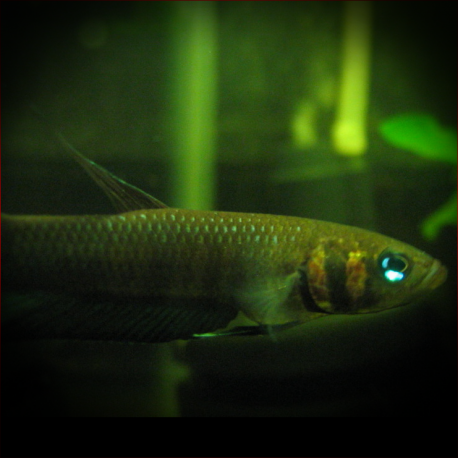More info
Datasheet
| Minimum Tank Size | 40 litres / 10.57 US gallons |
| Maximum Size | 4.5cm / 1.77inches |
| Temperature | 22°C / 71.60°F - 28°C / 82.40°F |
| Hardness | 1.01dgH / 18ppm - 5.04dgH / 90ppm |
| pH | 5.0-7.0 |
General Description
Betta krataios, previously traded as B. sp. 'Kapuas', is a small labyrinth fish distinguished by its rounded caudal fin and yellowish-brown body coloration. Belonging to the family Osphronemidae, it is a part of the Betta dimidiata group, characterized by elongate body shape, extended fins in males, and distinct color patterns. With almost 70 recognized members in the genus, Betta krataios is a notable addition known for its sturdy build and interesting behavioral interactions in group settings.
Aquarium Setup
In a tank of at least 40 liters, Betta krataios thrives best in a fully-decorated environment without a substrate. Driftwood, roots, and dried leaf litter provide natural shelter and encourage the growth of microbe colonies, enhancing the tank's ecosystem. Maintaining dim lighting, adding aquatic plant species like Microsorum and Cryptocoryne, and ensuring soft, acidic water conditions with gentle filtration are crucial for the well-being of this species (see table).
Behaviour
Being a solitary species, Betta krataios is best kept alone or with very peaceful tank mates to prevent intimidation or competition. In pair or group settings, these fish exhibit intriguing behavioral interactions, adding a dynamic aspect to their tank environment. Compatible with small cyprinids and loaches, proper research before introducing tank companions is essential to maintain harmony.
Feeding and Diet
In nature, Betta krataios preys on insects and small invertebrates. While they readily accept dried foods in captivity, a diet rich in live or frozen options like Daphnia and bloodworms ensures optimal coloration and health. Care should be taken to avoid overfeeding and monitor the fish's condition, as obesity is a common issue among Betta species.
Reproduction & Dimorphism
As paternal mouthbrooders, Betta krataios requires a separate breeding tank with a tight-fitting cover to ensure proper development of fry. The courtship involves a unique embrace where the male fertilizes and cares for the eggs in his mouth. Males exhibit sexual dimorphism with larger size, iridescent scaling, and extended fins compared to females, making them easily distinguishable.
Habitat and Distribution
Naturally found in forest swamp streams and pools, Betta krataios thrives in shaded, shallow waters with minimal dissolved minerals and a substrate of fallen leaves and branches. Endemic to the lower River Kapuas basin in western Kalimantan, Borneo, this species has been documented in localities like Pontianak, Sanggau, and Mandor.
Note: Please refer to the table for specific water condition requirements and tank setup details.

